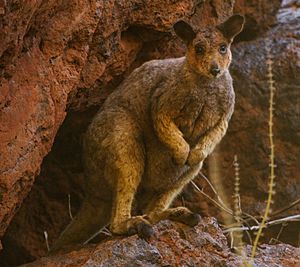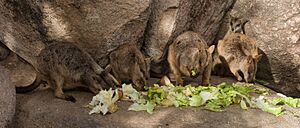Rock-wallaby facts for kids
Quick facts for kids Rock-wallaby |
|
|---|---|
 |
|
| Rothschild's rock-wallaby | |
| Scientific classification |
|
| Kingdom: | Animalia |
| Phylum: | Chordata |
| Class: | Mammalia |
| Infraclass: | Marsupialia |
| Order: | Diprotodontia |
| Family: | Macropodidae |
| Subfamily: | Macropodinae |
| Genus: | Petrogale Gray, 1837 |
| Type species | |
| Kangurus pencillatus Gray, 1827
|
|
| Species | |
|
19, see text |
|
The rock-wallabies are a special type of wallaby found in Australia. They belong to a group of animals called Petrogale. These amazing creatures are known for living in rocky, rugged places. They are very good at climbing and jumping among the rocks.
Contents
What Are Rock-Wallabies?
Rock-wallabies are medium-sized marsupials. They usually weigh between 1 and 12 kilograms. Males are a bit bigger than females. Their bodies can be up to 59 centimeters long, and their tails can be up to 70 centimeters long. Many rock-wallaby species have colorful fur.
Where Do They Live?
Rock-wallabies love places with lots of rocks. They live in steep, rocky areas with caves, overhangs, or thick plants. These spots give them safe places to hide during the day. They are nocturnal, meaning they are most active at night. They come out to find food three hours before sunrise and after sunset.
Rock-wallabies usually live in small groups or colonies. Each animal has its own home area, which is about 15 hectares. Males often have territories that overlap with several female territories. Even at night, they don't go further than two kilometers from their safe rocky homes.
There are three main types of rocky homes they prefer:
- Loose piles of big boulders with many hidden tunnels and spaces.
- Cliffs with lots of ledges and caves.
- Tall, isolated rock stacks, often with fallen boulders around them.
Because these special homes are limited, different groups of rock-wallabies can become separated. This can lead to unique genetic differences in each colony.
Different Kinds of Rock-Wallabies
Scientists have found 19 different species of rock-wallabies. They are all part of the Petrogale group. Here are some of the known species:
Short-eared Rock-Wallaby Group
- Short-eared rock-wallaby, Petrogale brachyotis
- Monjon, Petrogale burbidgei
- Nabarlek, Petrogale concinna
- Eastern short-eared rock-wallaby, Petrogale wilkinsi
Yellow-footed Rock-Wallaby Group
- Proserpine rock-wallaby, Petrogale persephone
- Rothschild's rock-wallaby, Petrogale rothschildi
- Yellow-footed rock-wallaby, Petrogale xanthopus
Brush-tailed Rock-Wallaby Group
- Allied rock-wallaby, Petrogale assimilis
- Cape York rock-wallaby, Petrogale coenensis
- Godman's rock-wallaby, Petrogale godmani
- Herbert's rock-wallaby, Petrogale herberti
- Unadorned rock-wallaby, Petrogale inornata
- Black-flanked rock-wallaby, Petrogale lateralis
- Mareeba rock-wallaby, Petrogale mareeba
- Brush-tailed rock-wallaby, Petrogale penicillata
- Purple-necked rock-wallaby, Petrogale purpureicollis
- Mount Claro rock-wallaby, Petrogale sharmani
Why Are Rock-Wallabies in Danger?
The number of rock-wallabies has dropped a lot since people from Europe settled in Australia. Some groups in the south have even disappeared completely.
It's a big worry that colonies are still dying out today. For example, in 1988, 80 rock-wallabies were released at Jenolan Caves in New South Wales. People thought there were many wild wallabies there already. But by 1992, only about seven were left. The remaining ones were caught and put into a safe area protected from foxes and cats. Their numbers have started to grow again in this protected space.
Scientists believe that red foxes are a major reason for the recent disappearances. Other problems include:
- Competition for food with other animals like goats, sheep, and rabbits.
- Diseases like toxoplasmosis and hydatidosis.
- Their homes being broken up or destroyed.
- Less healthy genes because colonies are becoming more isolated.
Helping Rock-Wallabies Survive

To help rock-wallabies, it's most important to protect their homes and control pests like red foxes and goats.
Groups like the Foundation for National Parks & Wildlife are working hard to save them. They have programs that include:
- Buying land to protect their habitat.
- Breeding rock-wallabies in safe places to increase their numbers.
- Teaching people about rock-wallabies and why they need help.
Scientists also keep a close eye on rock-wallaby populations to see if their numbers are changing. They study the genetic diversity of different groups. Getting rid of red foxes and goats helps local populations survive. Breeding programs act like an "insurance policy" to make sure there are enough rock-wallabies to release back into the wild.
Thanks to these efforts, the yellow-footed rock-wallaby in New South Wales has been saved from disappearing.
See also
 In Spanish: Ualabíes rupestres para niños
In Spanish: Ualabíes rupestres para niños

